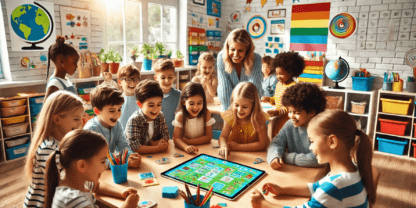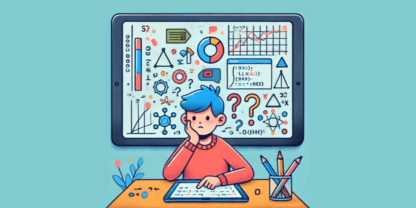Imagine you’ve traveled back in time about 40 years and someone asks you, “What is the capital of Poland?” You might know it already—maybe your family is Polish or maybe you were forced to memorize it in an elementary geography lesson. If not, you might think about consulting one of those big plastic globes that decorated every classroom. Worst case scenario, you might have to track down a good old-fashioned map. Try handing a student a map today, and you might find them asking, “Why is it not talking to me?”
Today, of course, all you have to do is pick up your phone and make a few taps or shout across the room, “Alexa, what is the capital of Poland?” After you do this, you will have your answer, write it down, shout it out to whoever was asking, and then forget it until you search for it again. In a world where our path to knowledge has changed so drastically, how can we redefine learning to set our students up for success?
The point is that there used to be more difficult steps to get to an answer to a question like this. For a student, maybe the answer itself isn’t the most important part, but the important part is all of the steps that it takes to get to an answer. In a world where our path to knowledge has changed so drastically, how can we redefine learning to set our students up for success?
As someone who has introduced AI tools to educators from all walks of life and all levels of tech-savviness, I’ve seen firsthand the lightbulb moments that come with a subtle shift in mindset. From seasoned veterans to teaching newcomers, the realization that AI can simplify and enhance an educator’s work is a game-changer. AI is not just for techies, it’s for anyone ready to transform their learning to accommodate the next evolution of college- and career-readiness.
Fight Fire With Fire: How to Use AI to AI-Proof Your Lessons
Most educators can speak at length about the importance of productive struggle. We learn very little when “learning” just means asking a search engine or a smart device for the answer. It’s the process that matters, the grit required to power through and apply knowledge in new ways to solve complex problems.
The billion-dollar question now is: how can we encourage that kind of struggle when every student has most of the world’s collective knowledge at their fingertips every minute of the day? No students in history have had access to the vast amounts of information our students today have access to with just a few taps on a screen. That raises another question: How does the largely unexplored territory of AI add to or help with that same challenge we’ve been wrestling with for the entire 21st century?
The best place to start for most of the teachers I’ve worked with is by understanding the limitations of AI. Begin every lesson by asking yourself “Could a student use ChatGPT to complete this assignment in its entirety?” If so, it’s safe to assume that at least some of your students are doing just that, leading them down an endless loop wherein the only skill they’re developing is how to cut corners more effectively. This increases their dependence on technology and puts them in a bad spot when, eventually, they are forced to face real-world challenges that don’t have an AI-generated solution. Without achieving mastery of a topic or improving their critical thinking skills, they will not be able to apply AI outputs in meaningful ways and problem-solve with them.
Our message to educators is clear: “Terminate the arms race between cheating and anti-cheating technology and make it impossible to cheat by changing the way the material is presented.” This approach not only increases trust and integrity in the classroom, it also helps students learn how to use AI productively rather than covertly.
The 3 pillars of AI-proofing
- Encourage deeper thinking through Socratic questioning, real-world scenario-based questions, metacognitive questions, ethical dilemma questions, and questions that force the student to use their local environment.
- Assign more PBL activities. Projects that require consistent work over time. It’s harder for AI to assist in these assignments, as they often require a practical application, real-world problem-solving, and evolution of ideas. If students were to use AI on a larger project, they would be using it as a tool, not a crutch.
- Get creative by incorporating elements into assignments that AI cannot replicate. For example, consider video explanations where students submit a 15-second video to explain why they chose the writing points they did. Another option is adding on more multimodal responses. Making sure there is one aspect of the assignment that makes them go further than what AI can offer.
This can seem like a lot, but what most teachers don’t realize is that they can use AI to actually generate item banks, lesson plans, and assignments that meet all these criteria. You can use the same technology your students are using to cheat to create assignments specifically designed to push student expectations beyond AI’s capabilities.
A Lower Barrier to Entry than You Might Think
Many teachers enter Gruvy Education’s PD sessions with preconceived notions about how inaccessible AI is to them or how far away they are from getting any value out of the technology. After just four hours of training, almost all of them walk away amazed when it becomes clear that AI is not something that requires a degree in computer science. If you can use Google, you can use AI. Once they get over that mental hurdle, teachers can see results overnight—freeing up hours and hours of prep time that they can now use to connect with their students.
These two quotes, both from 30-year veteran educators, say a lot about just how accessible AI is for every teacher:
“As a 30-year veteran, this is one of the most valuable courses I’ve taken.”
“After 30 years in education, this ranks in my top 5. It’s practical, eye-opening, and truly transformative.”
The data we’ve been able to collect backs up that sentiment. Before attending an AI course, teachers’ confidence levels using AI in an educational setting average out to 3.47 out of 10. After the sessions, that confidence jumped to 7.33—more than doubling after just four hours of training. With just a little help, educators can use AI right now to bring exciting changes to the classroom, making education more engaging and tailored to every student.
AI Literacy Can’t Wait
A child who goes to a school that does not address or account for the existence of AI tools will almost assuredly struggle in the workforce of the future. Schools must devise new ways to ensure students are actually learning the curriculum and developing skills that can withstand technological advancements.
This approach is not just about getting students ready for future jobs. It’s about teaching them to think deeply and come up with new ideas in a world that’s getting more complicated. Our main goal is to make sure we use AI in schools the right way. We want to help our students not just know how to use AI tools (since many already do) but to use them in a good and ethical way. We shouldn’t simply give out our curriculum and tell kids to not misuse AI.
Remembering our own childhoods, we understand that kids might not always choose wisely, as they might not see the future effects of their actions. This is all part of growing up. However, we can thoughtfully nudge them towards the right path in a way that feels natural to them, without them even realizing they’re being guided. This way, we’re preparing a new group of leaders who are ready to face and solve big problems in the future.
About the Author
William Grube is the founder of Gruvy Education. He has expanded his impact within the educational sector by partnering with over 50 schools nationwide to offer AI training to their entire staff. His expertise and dedication to integrating artificial intelligence into education have led him to speak at numerous conferences across the country, sharing insights and strategies for teaching in the AI era.
William is currently pursuing an accelerated master’s degree in computer science at North Dakota State University. He is driven by a strong desire to contribute meaningfully to the field of education and artificial intelligence.


Stay Connected for More Expert Analysis
Keep yourself in the loop on all things AI in education, including the very latest expert analysis from the front lines. Enter your email address below for monthly updates delivered to your inbox.



